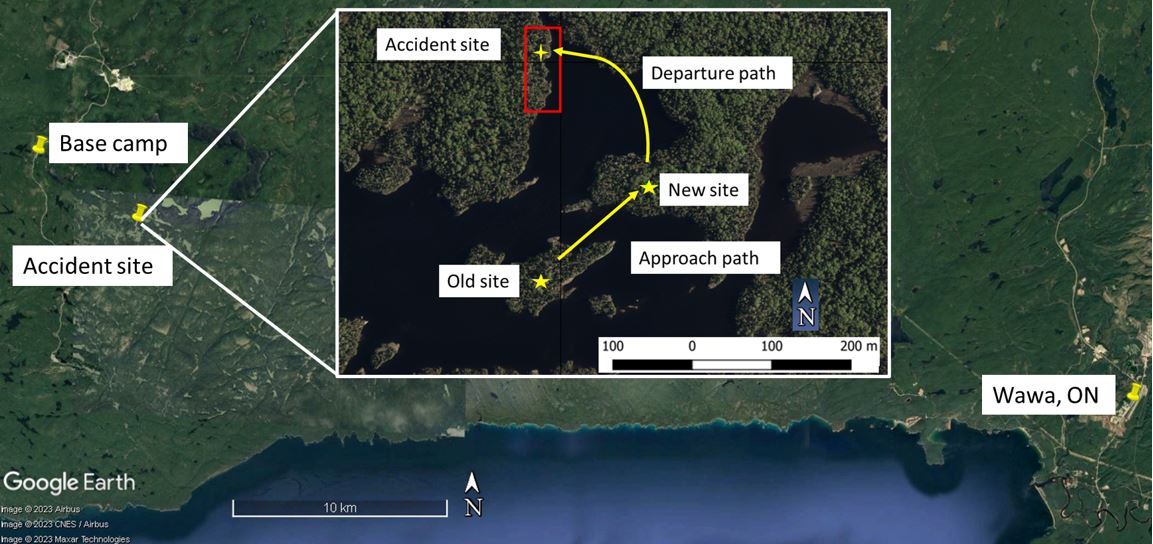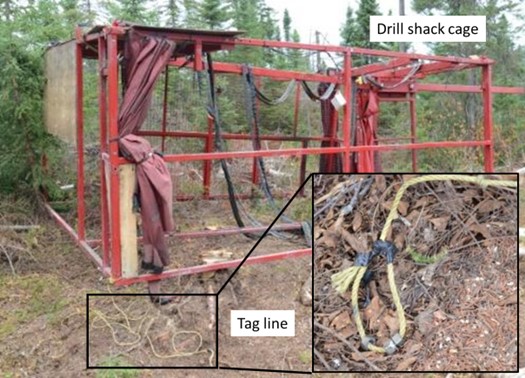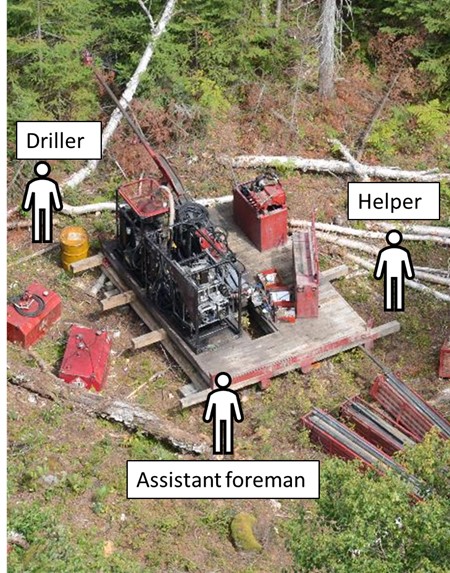Ground personnel entanglement with external load
G4 Drilling Canada Ltd.
and
Expedition Helicopters Inc.
Airbus Helicopters AS350 BA, C-FHAU
Wawa, Ontario, 25 NM W
The Transportation Safety Board of Canada (TSB) investigated this occurrence for the purpose of advancing transportation safety. It is not the function of the Board to assign fault or determine civil or criminal liability. This report is not created for use in the context of legal, disciplinary or other proceedings. See Ownership and use of content. Masculine pronouns and position titles may be used to signify all genders to comply with the Canadian Transportation Accident Investigation and Safety Board Act (S.C. 1989, c. 3).
History of the flight
On 20 August 2023, the Expedition Helicopters Inc. Airbus HelicoptersFootnote 1 AS350 BA helicopter (registration C-FHAU, serial number 2778) was conducting external load operations,Footnote 2 moving drilling equipment, in support of Angus Gold Inc.Footnote 3 mining exploration activities being conducted by G4 Drilling Canada Ltd. (G4)Footnote 4 approximately 25 nautical miles (NM) west of Wawa, Ontario. The pilot was alone on board and occupied the right seat. The single-engine helicopter was equipped and configured to conduct external load operations—the pilot door was removed, a vertical reference window was installed, and a 100-foot longline was being used. There were no overdue maintenance items or reported defects before the occurrence. The weather was suitable for the day visual flight rules flight. The winds at Wawa were reported as being from the north at 10 knots, variable from 320° to 050° true.
The pilot’s task consisted of transferring surface drilling equipment by longline from an old drill site on an island to a new drill site on a nearby peninsula, approximately 900 feet away (Figure 1). The G4 ground crew consisted of a foreman, an assistant foreman, a driller, and a helper.
The pilot started his duty day at approximately 0615Footnote 5 and flew various short flights for about 2.5 hours. He was then off duty until the first drilling equipment transfer flight, which started at approximately 1520.
The foreman and the assistant foreman were stationed at the old site, preparing and attaching the drilling equipment to the longline, while the driller and helper were at the new site receiving, positioning, and detaching the drilling equipment from the longline. By approximately 1630, only the drill shack cage remained to be moved (Figure 2). This cage was to be placed over the drill and equipment on the drilling platform at the new site.
When the cage is carried by longline, the pilot cannot control the rotation of the cage during the transfer or during the descent into position, so the ground crew uses tag linesFootnote 6 (Figure 2, inset) to help guide and position the cage down onto the platform.
When the helicopter reached the new site with the cage, the pilot, the driller, and the helper had difficulties positioning the cage. After several unsuccessful attempts, the pilot decided to bring the assistant foreman to the new site to help. The pilot flew back to the old site, released the cage, picked up the assistant foreman and took him to the new site. The pilot then returned to the old site, the cage was reattached to the helicopter, and the pilot flew back to the new site with the cage.
At approximately 1700, the pilot positioned the helicopter into the wind and lowered the cage over the drill. The driller and helper each held 1 tag line and the assistant foreman held 2 tag lines (Figures 3 and 4). When the pilot looked down through the vertical reference window, he could see the driller and the helper only, because a piece of plywood on top of the cage was blocking his view of the assistant foreman.
After some time still being unsuccessful in positioning the cage, the pilot transmitted over the radio to the driller, who was the only one who had a portable handheld radio, that he had to go refuel the helicopter. This radio communication went unheard by the driller. The investigation could not determine why it went unheard.
The pilot began to climb and lifted the cage slowly while paying attention to the cage and any hand signals from the ground crew. As he continued to lift the cage, he did not see any hand signals from the driller or helper, and assumed that he was clear and continued to lift. As the cage lifted, the assistant foreman became entangled in his 2 tag lines. The driller and helper were concentrating on their own tag lines and did not see the assistant foreman become entangled. As the helicopter climbed and departed, the assistant foreman was carried aloft. When the driller and helper realized that the assistant foreman was being carried away, the driller called the pilot on the radio to inform him. However, the radio call was made in French, and given that the pilot did not understand French, he could not understand what was being said. The pilot departed the area and climbed to approximately 200 to 300 feet above ground level over the nearby lake.
A few moments later, the driller and helper saw the assistant foreman fall. At 1722, the driller texted the project lead at the base camp to report the accident.
The pilot was still unaware of the accident but, hearing the tone in the driller’s voice over the radio, felt that something had gone wrong. He proceeded to the old site, dropped off the cage and asked the foreman to accompany him back to the new site. After landing at the new site, the pilot and foreman were made aware of the accident. The pilot returned to the base camp, refuelled, and returned with 2 passengers to search for the assistant foreman. He was found on land, in a forested area across the lake from the new site, and had been fatally injured.
Pilot information
The pilot held the appropriate licence and ratings to conduct the occurrence flight in accordance with existing regulations; he held a commercial pilot licence – helicopter and a valid medical certificate. He had accumulated over 4580 total flight time hours, which included over 1210 hours conducting longline operations and over 459 hours conducting precision longlineFootnote 7 operations.
The pilot had been hired by Expedition Helicopters Inc. in October 2022. He received both ground and flight training for Class B external loads and longline operations on 30 October 2022.Footnote 8 He was dispatched to work the Angus Gold Inc. project site on 09 August 2023.
There was no indication that the pilot’s performance was affected by medical or physiological factors.
Ground crew information
At the time of the occurrence, all ground crew involved in the occurrence were employees of G4.
All ground crew members were required to have completed Part 1 of a common core training program for surface diamond drillers developed by the Ontario Ministry of Labour, Immigration, Training and Skills Development. Given the type of work being performed, on-site specialty training, including a module on loading and unloading personnel and equipment from helicopters, was also required.
The surface diamond driller program is divided into 3 common core parts: Part 1 Basic level, Part 2 Helper level, and Part 3 Runner level. The program also includes specialty modules. Each part must be completed in sequence. The guidelines indicate that before starting the helper level common core training (Part 2), “the worker must, as a prerequisite, have completed all Common Core Part 1 modules and an industry recognized Basic slinging/rigging course which at a minimum covers instructions on selection and use of slings, attachments and lifting techniques. [emphasis in original]”.Footnote 9 All helper level, runner level, and specialty modules are to be trained at a project site, and must be completed within 12 months after the day the worker begins performing work.
The foreman, driller, and helper had completed all required common core training modules including the speciality module on loading and unloading personnel and equipment from helicopters.
The assistant foreman had been employed with G4 since 12 July 2023. He held a heavy equipment operator diploma. The investigation did not reveal any documentation indicating that the assistant foreman was qualified as a driller or that he had received any of the required common core or specialty module training.
External load operations
External load operations are used to transport a wide variety of materials, for various reasons, to a wide range of locations. To transport material related to drilling operations safely, the pilot and ground crew must work together as a team, and have a clear understanding of all procedures, communications, signals, and safety measures. This is of the utmost importance when the load is being moved near ground personnel.
Pilots need to make sure the load is moved slowly and clear of obstacles or entanglement to ensure safety for ground personnel. The ground crew must be vigilant at all times when the load is lowered or raised to avoid inadvertent contact or entanglement with the load or attached tag lines.
When it is not possible to position the load by hand, tag lines are used to help the ground crew while the load is being lowered to the ground. In this occurrence, closed weighted loops were made on the end of each tag line. The investigation determined that some G4 ground crew members put their hand in the loop or wrapped the tag line around an arm, wrist, or hand when handling the tag line attached to a load. Although the company did not have a standard procedure on how to use tag lines, this technique was a common practice with company crews. The investigation was unable to determine if the assistant foreman used this technique.
Communications and signals
Pilots and ground crews normally communicate using radios, hand signals, or both. Some handheld radios, such as the handheld transceiver used in this occurrence, have the speaker and microphone integrated into the body of the radio. If the users are not using a head set or boom mic, the external noise of the helicopter hovering overhead can be so loud that it can mask the strength, clarity, and comprehension of radio communications.
Using hand signals eliminates the need to manually operate the radio, and allows both the pilot and the ground crew to concentrate on the load and their respective tasks. Signals can also be an effective way to communicate if the ground crew and pilot do not speak the same language, as was the case in this occurrence. The ground crew members were all francophones and spoke English with some difficulty. The pilot was anglophone and did not understand French.
No matter the method of communication chosen, the method and signals, if applicable, should be pre-determined with the pilot before the lift, and communicated to all involved during training and ground briefings. The pilot will normally review the signals to be used with the ground crew, and inform them where they should be positioned so that they are visible to the pilot.
The investigation determined that the pilot had provided helicopter safety briefings to G4 ground crews at the start of his work on this project earlier in the month. Additional adhoc briefings were provided to the ground crews when various work or safety issues needed to be discussed. Often issues were simply discussed or resolved with the project lead or the foreman and did not require full briefings to all ground crews. There was no formal safety briefing to the ground crew on the day of the occurrence.
Previous occurrences
In 2006, Transport Canada produced a safety videoFootnote 10 to educate personnel conducting helicopter external load operations. The video focuses on ground crew safety and highlights a 2002 Canadian Coast Guard occurrence where a ground crew member was carried aloft when his foot became entangled in a cargo strap. The crew member was wearing a helmet with an integrated radio headset and was able to communicate with the pilot to ask that he be placed back on the ground, which the pilot did safely.
The Australian Transport Safety Bureau investigated an occurrence that took place on 23 May 2016, in which a ground worker “inadvertently stepped into the loop of a tag line. As the helicopter lifted the [load], the tag line went taught [sic], and the [worker’s] leg was ensnared in the loop. The [worker] was lifted off the ground […].”Footnote 11 The load master used a radio to contact the pilot, who returned and descended, but the worker fell from about 30 feet above the ground before the pilot could place him back on the ground. The worker received serious injuries.
The Swedish Accident Investigation Authority investigated an occurrence that took place on 16 November 2021, in which a ground crew member was caught by a cargo strap during helicopter external load operations. He was lifted several metres into the air before falling. The ground crew member was fatally injured.Footnote 12
On 18 August 2023, 2 days before the subject occurrence, the same pilot and G4 ground crew were conducting a drill move at a different drill site. In preparation to move the drill shack cage by longline, all rigging lines were attached to the cage. The assistant foreman then signaled to the pilot to start lifting the cage. As the helicopter climbed, the helper ran through the cage and was entangled in one of the rigging lines. He was lifted approximately 4 feet into the air before the assistant foreman signaled to the pilot to descend. The helper was lowered to the ground, and did not receive any injuries. The pilot and the ground crew discussed the incident amongst themselves; however, the incident was not reported to their respective companies.
Safety action taken
Angus Gold Inc.
Following this occurrence, Angus Gold Inc. has implemented an indoctrination session, which includes information on helicopter safety for persons, including contractors, accessing drill sites and working near or with helicopters. All indoctrination sessions and other required training are documented.
Angus Gold Inc. has also purchased noise-cancelling helmets that can be connected to the radios, and has implemented procedures for using these helmets when conducting longline operations.
G4 Drilling Canada Ltd.
G4 has modified its tag lines such that the thickness and rigidity of the line do not allow it to coil upon itself, making it more difficult to catch or entangle a person handling the line or equipment on the ground.
Safety messages
Pilots are reminded to ensure that all ground crew members are clear of loads before lifting the loads off the ground. At the same time, ground crew members need to be trained and must exercise caution and vigilance when working with external loads to avoid situations that could lead to entanglement.
Personnel who operate radios are reminded that communications need to be made clear by using language and terminology that can be understood by all parties involved, and these transmissions should be acknowledged to ensure that the message is understood. In addition, the communications equipment needs be suitable for the task and take into consideration the environment in which the communications are being made.
This report concludes the Transportation Safety Board of Canada’s investigation into this occurrence. The Board authorized the release of this report on . It was officially released on .



